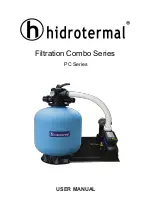
4
CORRUGATED HOSE CONNECTION
WITH WIRE CLAMP
TO POOL
RETURN
TO
WASTE
FROM
PUMP
WASTE LINE HOOK-UP
The discharge waste water will contain pool water
treatment chemicals that may harm certain plants and
vegetation. Therefore, position the discharge end of the
waste line in a safe, out-of-sight area capable of accept-
ing 150 to 200 gallons of waste water. Remove the
union fitting (Item 14) and union plug (Item 15) from the
valve port marked "WASTE." (See exploded illustration)
Install the union hose adaptor(Item 13), onto the port,
and replace union nut. Install a 1-1/2" inside diameter
waste discharge hose (not supplied) onto the the hose
adaptor. Before installing hose, slip a 1-1/2" hose clamp
(not supplied) over one end of the hose. Then, push
hose fully onto the waste port and tighten clamp firmly.
ELECTRICAL OUTLET
Refer to your pump owners guide for detailed informa-
tion pertaining to the requirements and regulations for
safe electrical installation of the power supply, recep-
tacle outlet, switching and ground fault interrupter.
FINISH FILLING POOL
Finish filling your pool, referring to skimmer installation
and pool assembly instructions for proper water level.
VALVE OPERATION
Your new filter has six positions of operation, which are
explained below. To change positions of the valve,
make sure the pump is OFF. Press down on the valve
handle enough to free the locking tab. Rotate the
handle so the tab LOCKS in the desired position.
FILTER: Normal pool filtering position. May also be
used when vacuuming the pool.
BACKWASH: Backwashing reverses the flow of water
through the filter to flush out dirt and debris, and waste
water is discharged to waste from the valve body port
marked "To Waste". (Duration is normally 1-1/2 to 2
minutes or until water runs clear.)
FILTER TO WASTE: Place the valve handle in the
“Filter to waste” position after backwashing your filter.
(Normally, for only 10 seconds).
PUMP TO WASTE: This position allows you to vacuum
heavy debris or larger amounts of settled contaminants
from the pool floor directly to waste.
RECIRCULATE POSITION: This position allows you to
increase the water flow rate to circulate chemicals
throughout the pool more quickly. Pool water passes
through the valve on top of the filter bypassing internal
filter components and travels back to the pool at a rapid
rate.
WINTERIZE POSITION: This position allows you to
drain trapped water from the filter valve and relieve
compression on the rotor valve gasket during winter
storage. CAUTION: Do not operate pump in this
position as waste water contaminants will be discharged
from the filter back into the pool.
(Normally, for only 10 seconds).
INITIAL START UP
Before you begin filtering your pool, the filter sand must
be backwashed thoroughly to remove the extra fine
sand grains normally found in new filter sand.
1.
Loosen the pump strainer pot lid to allow air to
escape. Tighten lid when water begins to flow
between strainer pot lid and strainer body. Do not
over tighten.
2.
Plug in your pump to the GFCI protected receptacle.
Refer to WARNINGS.
3.
Install a 1-1/2" waste line (Not supplied-See Waste
Line Hook-up). Be sure to route the hose to a safe
area.
4. Push down on the valve handle and rotate to the
BACKWASH position. Make sure valve handle
indexes into the tabs on cover.
5.
Start pump. During this initial start-up, allow 4 to 5
minutes to flush out the super-fine sand grains to
prevent them from plugging the underdrain slots.
Because pool water is lost during this operation
(150 to 200 gallons), keep a close check on pool
water level. Never let water level get so low that no
water flows to pump. Replenish as required.
6.
Stop pump. Push down on the valve handle and
rotate to the FILTER TO WASTE position. Start
pump and allow to run approximately 10 seconds to
eliminate any "cloudy puff" out the return fitting inlet,
then stop pump.
7.
Push down on the valve handle and rotate to the
filter position and start pump. Note the pressure
reading on your pressure gauge for future reference
of when to backwash.
8.
Check tank cover, all fittings and hoses for leaks
and tighten to correct as necessary.


























